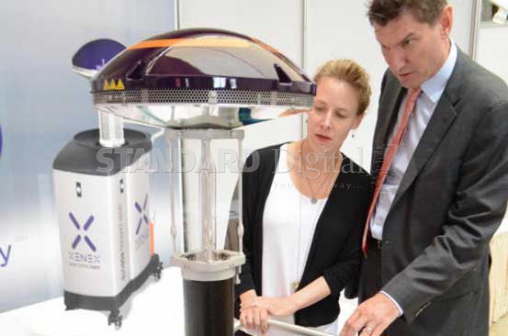
NAIROBI: Hospitals are the least of places you would expect to get infections. But it does happen, often.
The World Health Organisation (WHO) says of every 100 hospitalised patients at any given time, seven in developed and 10 in developing countries, will contract an infection.
However, there is a robotic device, Xenex, being used widely to help cut hospital infections.
The robot uses high intensity ultra violet (UV) light to disinfect a room and local health facilities are planning to acquire it due to the ability to destroy stubborn viruses and bacteria.
In an exclusive interview with the innovators, Dr Mark Stibich and his wife Dr Julie Stachowiak from the US, The Standard on Saturday learns that the working principle of the robot is based on a five-minute cleaning cycle, destroying contagious superbugs through high intensity ultra violet light.
“Dangerous microorganisms are found on high-touch surfaces throughout healthcare facilities and using this UV technology, the DNA of the pathogens that make patients sicker are destroyed,” said Dr Stibich.
According to the couple, who study the patterns, causes and effects of infectious diseases, the innovation was driven by need to bring down hospital-based infections resistant to antibiotics.
The innovation comes a few days after WHO launched a global campaign on the increased over-use and misuse of antibiotics leading to antimicrobial resistance.
“When we started this research in 2008, there was little information on how the environment contributed to hospital infection but studies now show that contaminated surfaces, equipment and individuals attending to the patient are active sources of infection,” said Dr Stibich added.
“Clean environments is our best bet in keeping infection rates at a minimum,” Dr Stachowiak noted.
Worryingly, more infections now resist common antibiotics, allowing them to spread and sometimes become life-threatening.
So how does the robot work to enhance germ-free environments?
Dr Stibich said the robot uses high intensity ultraviolet light produced by xenon flash lamps across the entire light spectrum destroying genetic material of bacteria, viruses and bacterial spores. The robot measuring about two metres high is placed in a room, plugged into a power source and the person operating it given 10 seconds to leave the room when the UV light is produced for the next five minutes.
“Because pathogens are vulnerable to UV-C light at different wavelengths depending on the organism, this light kills their DNA thus preventing them from repairing themselves, leaving the room germ-free,” said Dr Stibich.
“We also sought to investigate the duration of time that these microorganisms existed on these surfaces causing contamination,” his wife, Dr Stachowiak, added. The device is already in use in the US, Canada and Europe in 300 hospitals. In Africa Botswana, Namibia and South Africa are expected to adopt the robot.
Research recently done to assess the efficiency of the robot showed the hospitals reported a decrease of more than half of infections like MRSA and Clostridium difficile, Dr Stibich noted. Why should hospital environments be infection free?
“It is prudent to ensure the environment where care is provided, is germ-free the studies on its efficiency shows a promise to improve the quality of healthcare globally,” said Dr Stibich.
New data also shows the robot can kill the Ebola virus because it is sensitive to the UV light when tested on Personal Protective gear worn by health workers when attending to patients with highly contagious diseases.
“The infection risk was created during the removal of the protective gear after attending to a patient and this led to the contamination of the health care worker’s hands or other parts of their body. The robot reduces the probability of transmission when the health worker is done,” he added.
However, the innovators noted that adoption of the robot when removing the protective gear after attending to patients, was an additional layer of safety alongside strict adherence to laid-down procedures on the removal to reduce infections.
Three years ago, Dr Stibich was named one of Houston’s “40 Under 40” business leaders by the Houston Business Journal while his wife has extensively worked on HIV research and programmes in Russia as well as raising awareness on Multiple Sclerosis.
DISEASE SURVEILLANCE
The couple, who are also disease surveillance experts, said the robot could be rolled out simultaneously in Kenya and South Africa.
Dr Stibich explained that the device is being used in outpatient surgery centres and skilled nursing facilities in the US, Canada and parts of Europe.
A fortnight ago, the robot was successfully used to disinfect a biosafety level four laboratory.
Another infection prevention control specialist Dr Joost Hopman corroborated the findings of the couple adding that micro-organisms can be present in environments ranging from days to months, moving from one patient to another within the wards, hence prolonging hospital stay.
Dr Hopman cited contaminated equipment, healthcare workers, patients admitted for more than 40 days, family and friends as the main sources of contamination in hospital settings.
“Whereas hospital-based infections cannot be fully eliminated, frequent and thorough cleaning of the ward, removal of waste and linen, routine surveillance and prompt treatment of infections are some of the strategies to reduce prevalence of Hospital Acquired Infections,” he said.
 The Standard Group Plc is a multi-media organization with investments in media platforms spanning newspaper print
operations, television, radio broadcasting, digital and online services. The Standard Group is recognized as a
leading multi-media house in Kenya with a key influence in matters of national and international interest.
The Standard Group Plc is a multi-media organization with investments in media platforms spanning newspaper print
operations, television, radio broadcasting, digital and online services. The Standard Group is recognized as a
leading multi-media house in Kenya with a key influence in matters of national and international interest.











